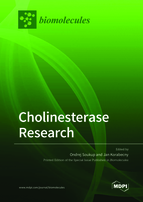Cholinesterase Research
A special issue of Biomolecules (ISSN 2218-273X). This special issue belongs to the section "Cellular Biochemistry".
Deadline for manuscript submissions: closed (30 June 2021) | Viewed by 39809
Special Issue Editors
Interests: Alzheimer's disease; acetylcholinesterase; butyrylcholinesterase; organic synthesis; anticancer drugs; kinase inhibitors; molecular modeling studies; medicinal chemistry; organophosphorus intoxication; chemical warfare agents; acetylcholinesterase reactivators; in silico studies
Special Issues, Collections and Topics in MDPI journals
Interests: Alzheimer’s disease; acetylcholinesterase; butyrylcholinesterase; cholinesterase; drug development; organophosphate poisoning; nerve agents; oxime reactivators; toxicology; military pharmacy; drug delivery; in vitro testing; in vivo; toxicokinetics
Special Issues, Collections and Topics in MDPI journals
Special Issue Information
Dear Colleagues,
Cholinesterases are fundamental players in the peripheral and central nervous systems. These serine hydrolases are presented by two-membered families, namely acetylcholinesterase (AChE) and butyrylcholinesterase (BChE). Under physiological conditions, AChE terminates the action of acetylcholine at synapses. The peculiar capacity of AChE also indicated, among others, its involvement in the differentiation of embryonic stem cells, neuritogenesis, cell adhesion, synaptogenesis, activation of dopamine neurons, amyloid beta fibre assembly, haematopoiesis and thrombopoiesis, or regulation of glutamate-mediated hippocampal activity. For AChE, its abrupt blockade has fatal consequences. This phenomenon is typical for a class of highly toxic compounds—nerve agents and pesticides, which can irreversibly inhibit enzymes. The role of BChE is still extensively discussed; it plays an important role in cholinergic mediation, it contributes to neurogenesis, and has detoxifying effect towards different xenobiotic drugs. It is also assumed that BChE overtakes the function of AChE in the case of malfunction.
Based on the abovementioned, both AChE and BChE are considered as highly relevant targets in the field of medicinal chemistry. For neurodegenerative disorders like Alzheimer’s disease, there is a strong consensus that AChE and BChE targeting by reversible inhibitors can, at least temporarily, alleviate the symptoms associated with the disorder, and enhance the cognitive performance of individuals. Other cholinesterase ligands, namely cholinesterase reactivators, typically endowed with strong nucleophilic function, can revert the irreversible action of organophosphorus compounds (nerve agents and pesticides). However, there are many other areas of research involving AChE and BChE, for example, pesticides; inflammation; and other neuronal disorders like Lewy body dementia, Parkinson’s disease, myasthenia gravis, and so on.
For this Special Issue of Biomolecules, “Cholinesterase Research”, we encourage the submission of review or original research articles that encompasses cholinesterase research at different levels, including structural aspects, drug design and development, in vitro biochemical studies, animal studies, and computational approaches, all devoted primarily to cholinesterases.
Prof. Dr. Jan Korabecny
Dr. Ondrej Soukup
Guest Editors
Manuscript Submission Information
Manuscripts should be submitted online at www.mdpi.com by registering and logging in to this website. Once you are registered, click here to go to the submission form. Manuscripts can be submitted until the deadline. All submissions that pass pre-check are peer-reviewed. Accepted papers will be published continuously in the journal (as soon as accepted) and will be listed together on the special issue website. Research articles, review articles as well as short communications are invited. For planned papers, a title and short abstract (about 100 words) can be sent to the Editorial Office for announcement on this website.
Submitted manuscripts should not have been published previously, nor be under consideration for publication elsewhere (except conference proceedings papers). All manuscripts are thoroughly refereed through a single-blind peer-review process. A guide for authors and other relevant information for submission of manuscripts is available on the Instructions for Authors page. Biomolecules is an international peer-reviewed open access monthly journal published by MDPI.
Please visit the Instructions for Authors page before submitting a manuscript. The Article Processing Charge (APC) for publication in this open access journal is 2700 CHF (Swiss Francs). Submitted papers should be well formatted and use good English. Authors may use MDPI's English editing service prior to publication or during author revisions.
Keywords
- acetylcholinesterase
- butyrylcholinesterase
- cholinesterase
- drug design and development
- nerve agents
- oxime reactivators
- antidotes
- in silico approaches
- in vitro studies
- in vivo evaluation
- medicinal chemistry
- computational chemistry








